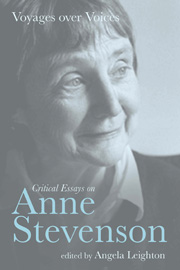Book contents
- Frontmatter
- Contents
- Notes on Contributors
- Acknowledgements
- ‘Making Poetry’
- 1 ‘Voyages over voices’: Introduction
- 2 The Melting Metaphor
- 3 ‘Between us’: Letters and Poems of Stevenson and Bishop
- 4 Mothers, Mirrors, Doubles: Anne Stevenson's Elegies for Sylvia Plath
- 5 Staging Second Thoughts: The Poetry of Anne Stevenson
- 6 ‘Making Poetry’: The Exemplary Anne Stevenson
- 7 ‘A curved adventure’: Romanticism and the Poetry of Anne Stevenson
- 8 The Nature of Anne Stevenson
- 9 Anne Stevenson and the Poetry of Place
- 10 Compacting Time: Anne Stevenson's Poems of Memory
- 11 ‘Not exactly a persona’: Pronouns in Anne Stevenson's Poetry
- 12 ‘To serve a girl on terrible terms’: Anne Stevenson's Writing Selves
- 13 Talking and Singing: Anne Stevenson's Variations on a Rhythmical Theme
- 14 ‘Time will erase’: Anne Stevenson and Elegy
- 15 Observing the Overhearing: The Anne Stevenson Papers in Cambridge University Library
- 16 Bibliography of Anne Stevenson's Published Works
- General Index
- Index of Stevenson's Works
2 - The Melting Metaphor
- Frontmatter
- Contents
- Notes on Contributors
- Acknowledgements
- ‘Making Poetry’
- 1 ‘Voyages over voices’: Introduction
- 2 The Melting Metaphor
- 3 ‘Between us’: Letters and Poems of Stevenson and Bishop
- 4 Mothers, Mirrors, Doubles: Anne Stevenson's Elegies for Sylvia Plath
- 5 Staging Second Thoughts: The Poetry of Anne Stevenson
- 6 ‘Making Poetry’: The Exemplary Anne Stevenson
- 7 ‘A curved adventure’: Romanticism and the Poetry of Anne Stevenson
- 8 The Nature of Anne Stevenson
- 9 Anne Stevenson and the Poetry of Place
- 10 Compacting Time: Anne Stevenson's Poems of Memory
- 11 ‘Not exactly a persona’: Pronouns in Anne Stevenson's Poetry
- 12 ‘To serve a girl on terrible terms’: Anne Stevenson's Writing Selves
- 13 Talking and Singing: Anne Stevenson's Variations on a Rhythmical Theme
- 14 ‘Time will erase’: Anne Stevenson and Elegy
- 15 Observing the Overhearing: The Anne Stevenson Papers in Cambridge University Library
- 16 Bibliography of Anne Stevenson's Published Works
- General Index
- Index of Stevenson's Works
Summary
One of the twentieth century's most memorable and amusing figures for the writing of poetry is Robert Frost's ‘Like a piece of ice on a hot stove the poem must ride on its own melting.’ Typically, it was Frost who undermined his own simile, insisting, in a 1931 talk called ‘Education by Poetry’, that ‘all metaphor breaks down somewhere’. By viewing the whole concept of figurative language as inconclusive, he freed it from carrying too much responsibility for consistency. ‘It is touch and go with the metaphor,’ he wrote. ‘That's the beauty of it. Until you have lived with it long enough you don't know … how much you can get out of it and when it will cease to yield.’ Likening the act of writing a poem to ice melting on a stove proved Frost's point. The simile breaks down right away: a piece of ice on a stove invariably evaporates and disappears, whereas the test of a successful poem is that, having melted itself more or less from delight to wisdom, it remains in the canon as a work of literature, a work of art.
Whatever the limitations of the melting ice metaphor, it is certain that figures of speech are not only the stuff of poetry; they are built right into our language. They are part of the mechanism through which we work with words to make words work for us. By language I do not mean the noises people make in circumstances of extreme distress or pleasure. Babies cry, lovers moan, a man pushed off a cliff hollers Aaaaah. I can’t think of such outcries as language because verbal communications must be to some extent creations of the mind – or more accurately, of many minds coming to (changeable) agreements or adopting habits over hundreds of years about what, approximately, certain repeatable noises or combinations of sounds and symbols mean. Nothing is ever fixed about language.
- Type
- Chapter
- Information
- Voyages over VoicesCritical Essays on Anne Stevenson, pp. 14 - 27Publisher: Liverpool University PressPrint publication year: 2010

